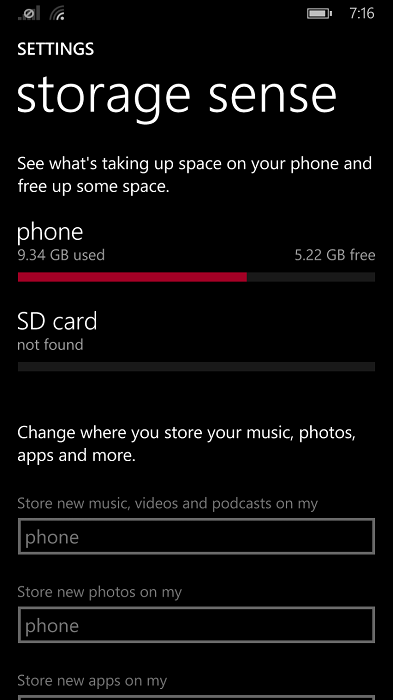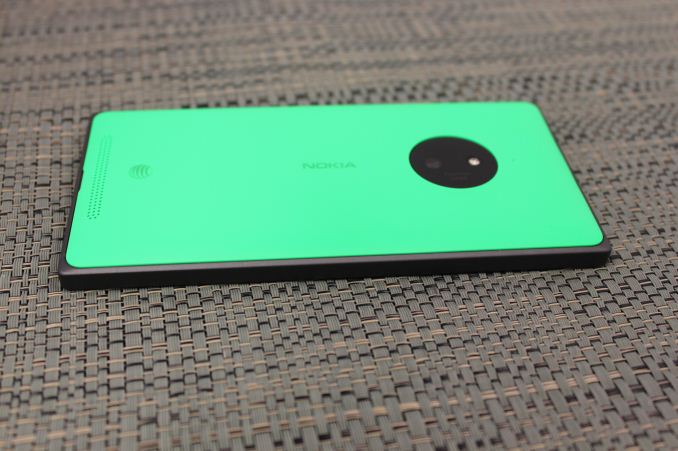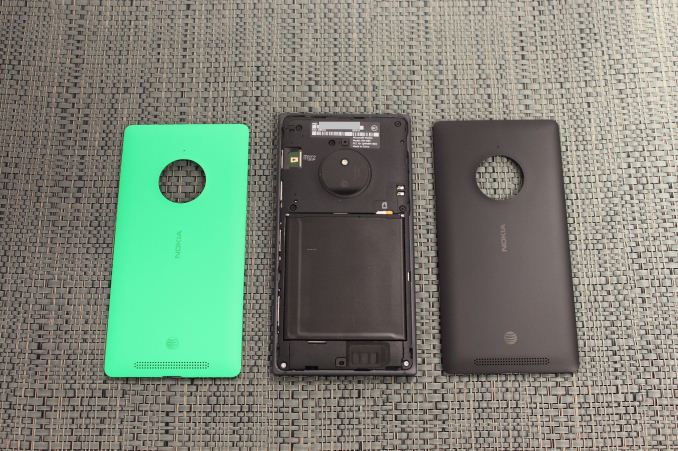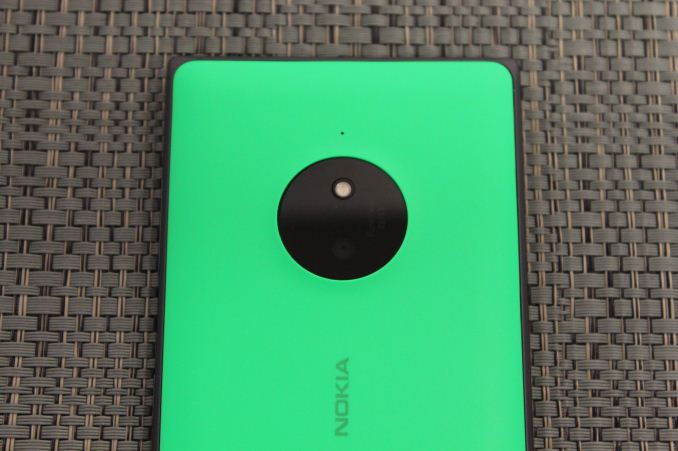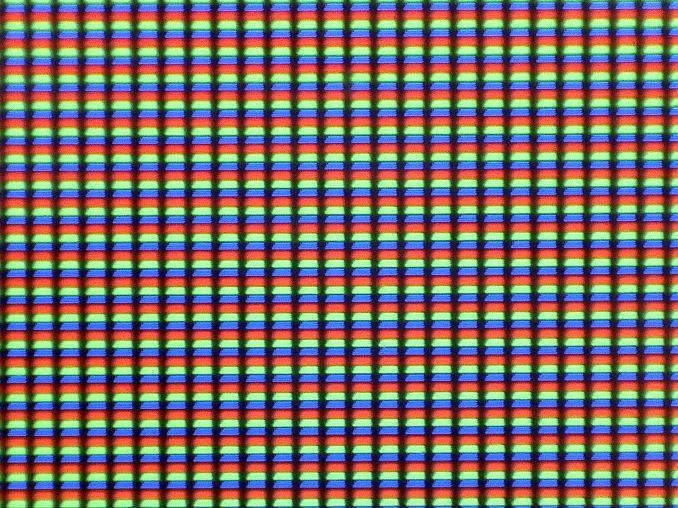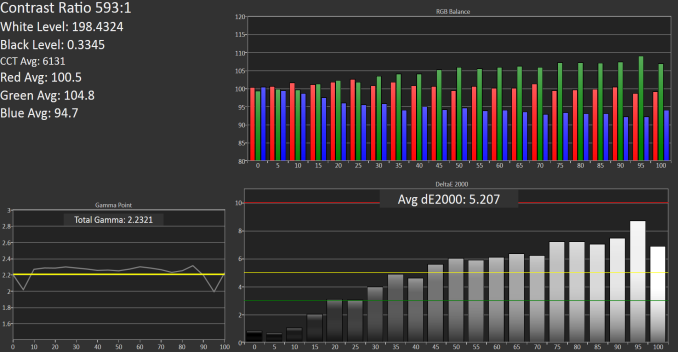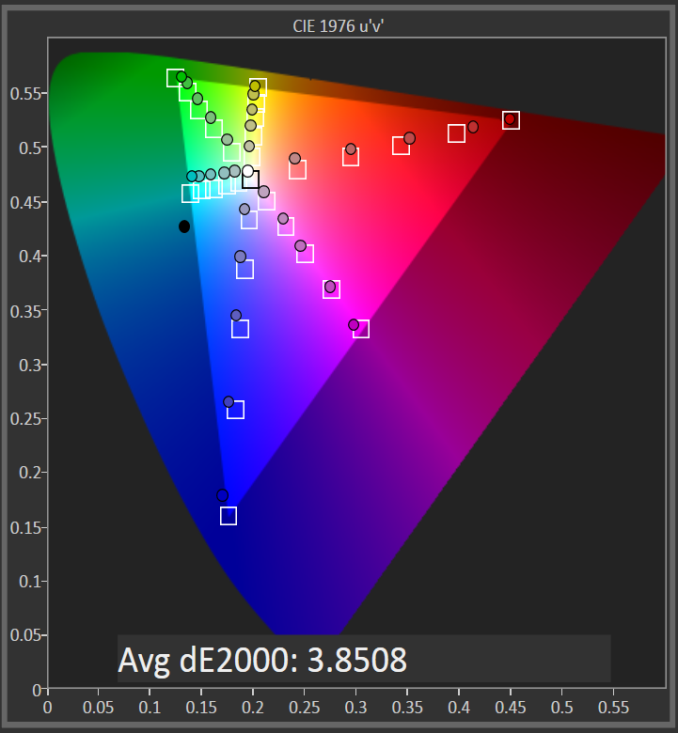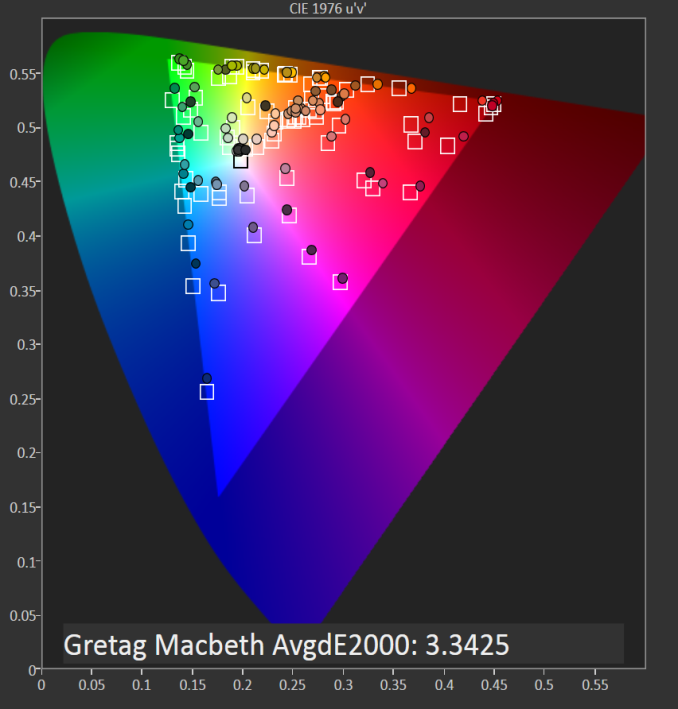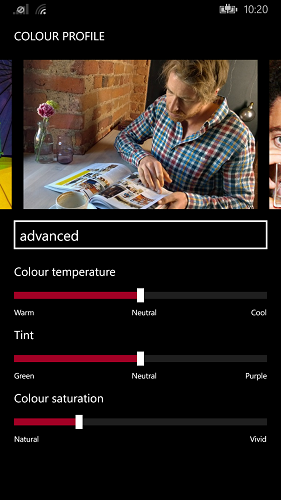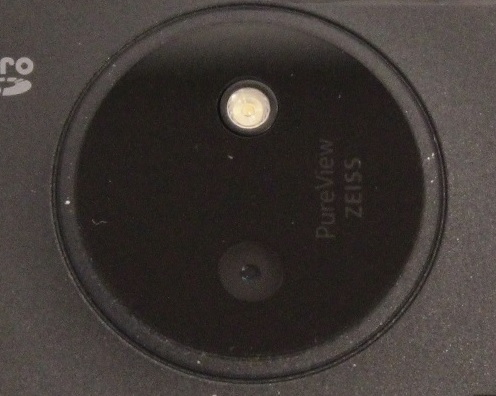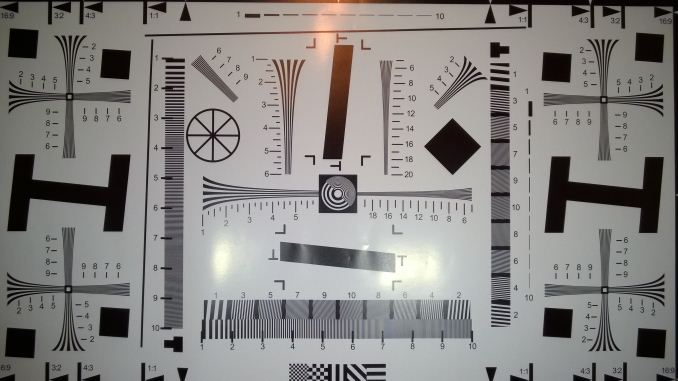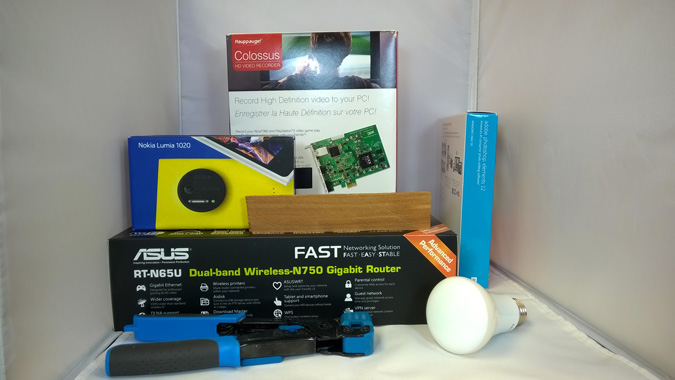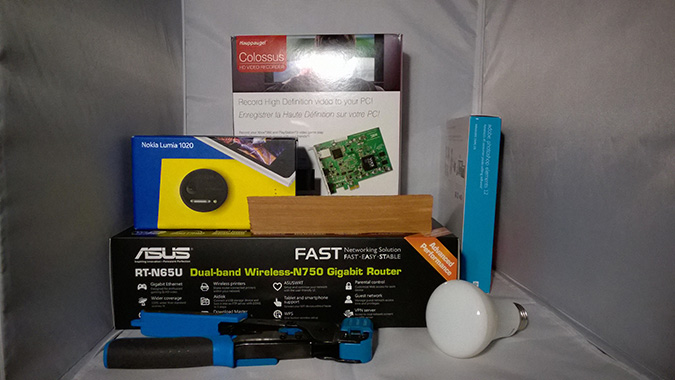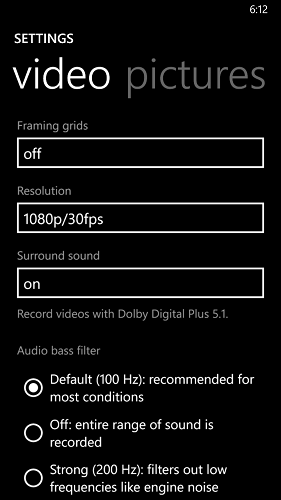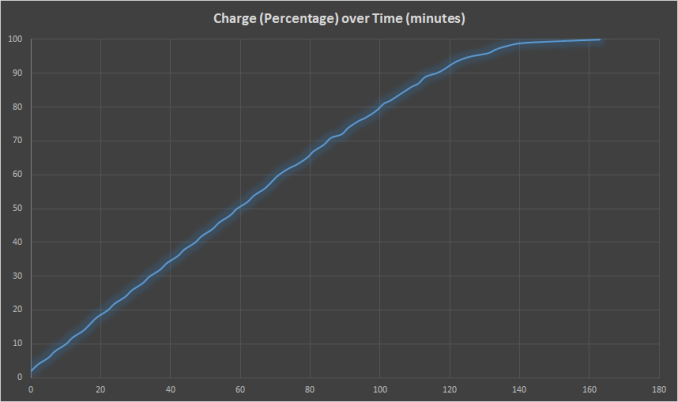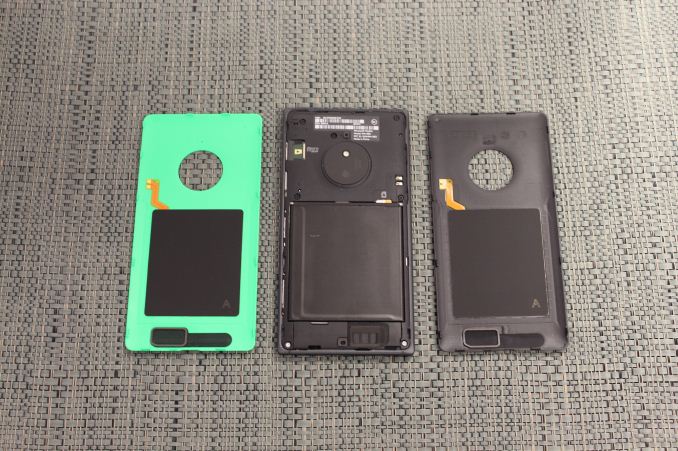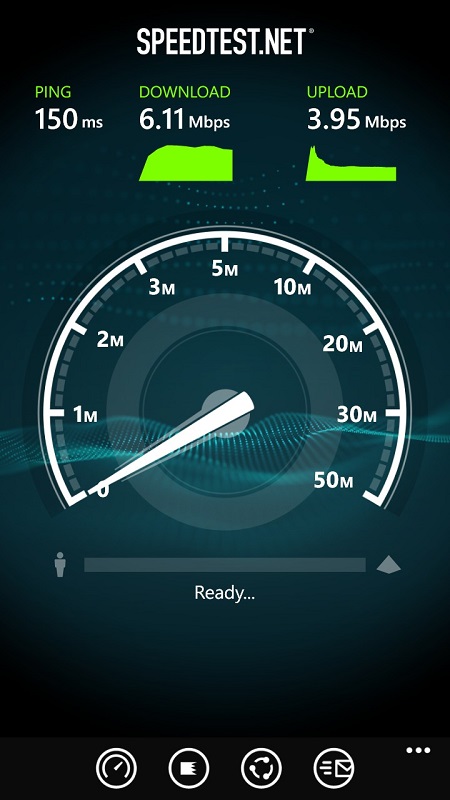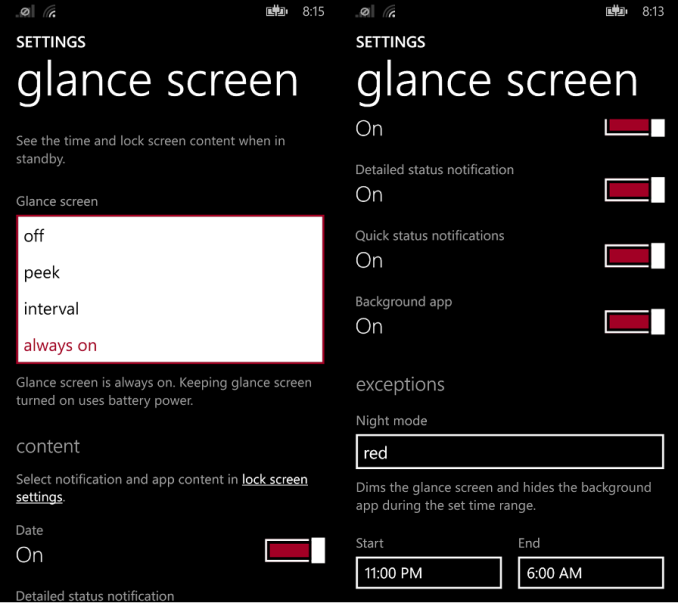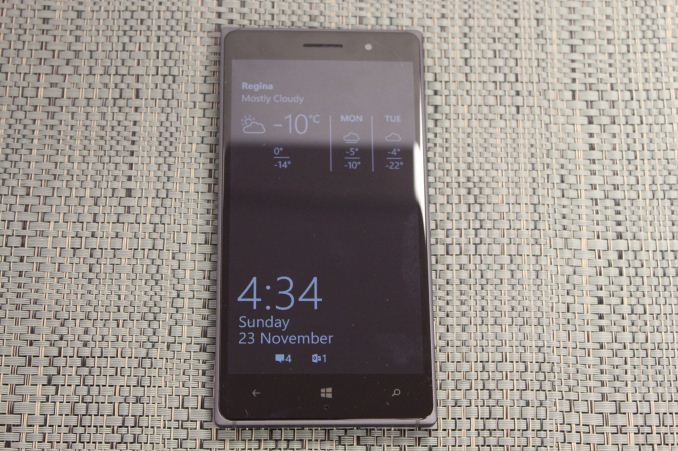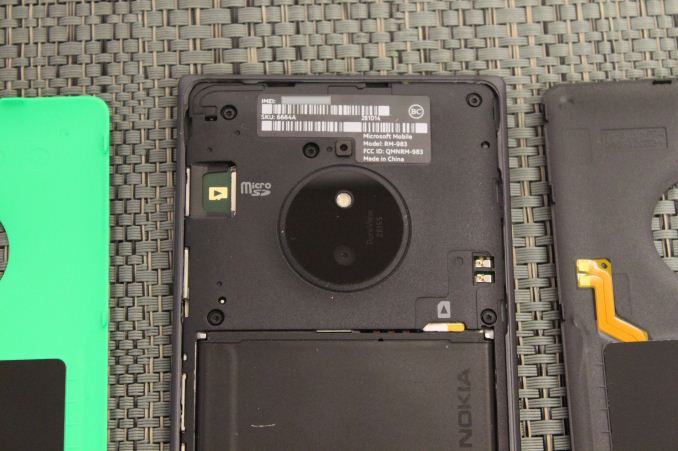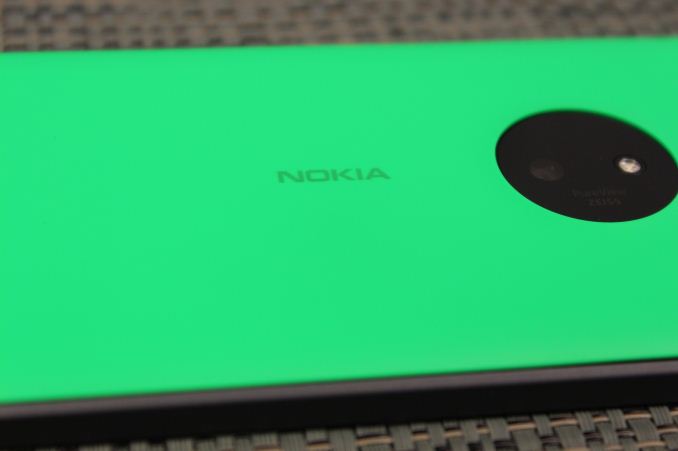
Original Link: https://www.anandtech.com/show/8726/nokia-lumia-830-review
Nokia Lumia 830 Review
by Brett Howse on November 25, 2014 8:00 AM EST- Posted in
- Microsoft
- Smartphones
- Lumia
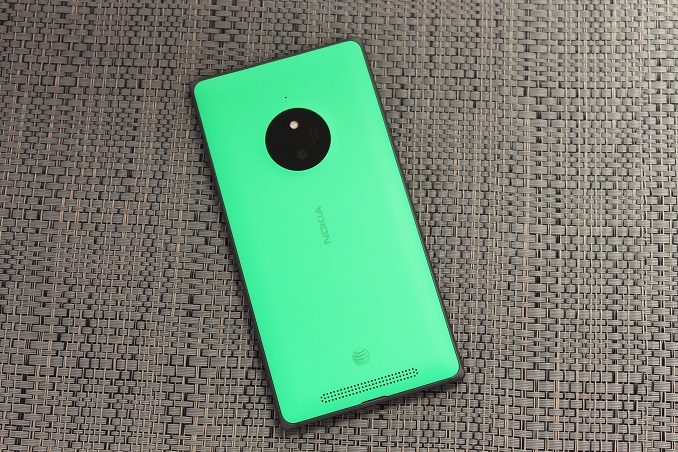
The Lumia 830 was launched by Microsoft at the IFA trade show in September. As seems to be the norm for most Nokia phones, it has taken a short while for announced phones to be generally available, but the Lumia 830 can now be found in many markets. When it was announced in September, it was marketed as an “affordable flagship” and we will take a look and see how it lives up to that kind of marketing. But marketing phrases aside, what we are left with is one of the best Nokia phones launched this year.
Unfortunately for fans of Nokia phones, there has not been a real flagship phone announced since the Lumia Icon/930 which came back in February. We did review that phone, and while it was quick and had a nice 20 MP camera, the battery life was subpar and it felt very thick and dense to carry around. It lacked Nokia’s Glance display, which is a big downside when coming from previous Nokia phones that support it.
The Lumia 830 is not going to fill a gap here as far as performance, which is a shame. The Lumia 830 shares the same SoC – the Qualcomm Snapdragon 400 – as the Lumia 630, 635, 730, and 735. There is no substitute for performance, and the quad-core Cortex A7 at 1.2 Ghz is not the quickest chip around. In the Lumia 630 review, I found the quad-core A7 design slightly slower than the dual-core Krait of last year’s Snapdragon S4 Pro in pretty much all benchmarks. It is a shame due to the marketing and price of the Lumia 830 that it did not jump up to at least the Snapdragon 600. With that SoC, perhaps the moniker of “affordable flagship” could have held up.
Let us take a look at what makes up the Lumia 830.
| Nokia Lumia 830 | |
| SoC | MSM8926 1.2 GHz Snapdragon 400 |
| RAM/NAND | 1 GB LPDDR2, 16 GB NAND + microSD 128 GB |
| Display | 5.0” 1280x720 IPS ClearBlack LCD Corning Gorilla Glass 3 |
| Network | GSM/GPRS/EDGE/HSPA/LTE up to 150 Mbps |
| Dimensions | 139.4 x 70.7 x 8.5 (mm) |
| Weight | 150 grams |
| Rear Camera | 10MP, 1.1 µm pixels, 1/3.4" 16x9 CMOS, f/2.2, 26 mm focal length, LED Flash |
| Front Camera | 0.9MP wide angle, f/2.4, 1280x720 video resolution |
| Battery | BV-L4A 2200 mAh, 3.8 V, 7.04 Wh |
| OS | Windows Phone 8.1 with Lumia Denim Firmware |
| Connectivity | 802.11 a/b/g/n + BT 4.0, USB2.0, DLNA, FM Radio |
| Location Technologies | Cellular and Wi-Fi network positioning, A-GPS, A-GLONASS, BeiDou |
| SIM Size | Nano SIM |
As you can see, we have pretty standard fare for a Lumia phone launched this year. The previously mentioned Snapdragon 400 is paired with 1 GB of memory, and 16 GB of internal NAND. The Lumia 830 supports microSD card expansion up to an additional 128 GB. With the Windows Phone Storage Sense app, storage should not be an issue - Windows Phone has moved from having practically zero support for microSD to now having the best support of all of the mobile operating systems.
A big part of any smartphone experience is the design of the phone, and Nokia (now Microsoft of course) has crafted one of their best experiences yet.
Design
The five inch display size seems to be what device makers have identified as being what people want in a normal smartphone. A good chunk of the smartphone market now has a display at or around five inches. Any larger, and the device can become unwieldy and require two hands for use (which is fine if that is what you are after) and once you use a five inch phone, those around four to four and a half inches seem kind of small. So the Lumia 830 comes in with the same display size as the Lumia 930 right at five inches.
Where the Lumia 930 started to go wrong, at least for me, was that it was too thick and too heavy. It could have likely gotten away with the thickness if the sides were rounded off, but the Lumia 930 took cues from the Lumia 928 and had squared off sides, with a slightly contoured polycarbonate back. The premium feel came from the metal edge wrapped around the phone.
The Lumia 830 shares the same basic design as the Lumia 930, with a squared off side made of aluminum, and a contoured polycarbonate back. The 830 is a bit thinner and a bit lighter than the Lumia 930, and it sounds small on paper but it really changes the in-hand feel of the phone. The 930 would slightly dig into my hands with the sharp contours, but the Lumia 830 does not do this at all. In hand feel is very good. To make this device as thin as they did, the manufacturer has designed its thinnest Optical Image Stabilization (OIS) system to date. The thinner OIS is likely in part due to the smaller main camera sensor.
The Lumia 830’s polycarbonate back comes in several colors, as is the norm for Nokia phones. The 830 is available in white, black, green and orange. Devices sold with a black back will have a dark grey aluminum strip around the outside, whereas the other colors come with a bright silver band. One great feature of the Lumia 830 over the 930 is that on the 830, the back is removable. Simply pry up at the bottom where there is a small slot, and the back pops off to expose the 2200 mAh battery, SIM tray, and microSD card slot. The 930 did not have microSD, so this is a bonus for the 830 for sure. People who swear by removable batteries will also be happy with this change. It gives the 830 a similar, but somewhat better in-hand feel over the 930, but keeps the perks of a removable back. Hopefully this is something we will see continue on future Microsoft branded handsets.
At the top of the phone we have our normal 3.5mm headset jack, and for the first time in a while on a Nokia Windows Phone, the USB port is also at the top. I prefer the port at the bottom myself, but it certainly is not a big enough deal to worry about. The Lumia 830 supports Qi wireless charging in the case, perhaps indicating a potential usage shift for the Lumia market. In order to make this shift more palatable, it would make sense if some vendors may bundle a Qi charger.
On the right side is the three Windows Phone hardware buttons which are the volume, power, and a two-stage camera button. Nokia's Windows Phones below the 830 have gotten rid of the camera button, which is a poor choice right now since the operating system is not set up to handle this very well, so it is great to see it on the 830. As far as the range of Nokia phones goes, it appears those branded with “PureView” cameras will have OIS and a camera button, so the Lumia 830 fits the bill here.
On the left side, there are no buttons to take away from the aluminum feel. On the bottom, there are also no buttons and no features at all except the two plastic strips which separate the aluminum bands to allow them to be used as antennae.
The design is one of the highlights of the Lumia 830, and perhaps this is where they get the “affordable flagship” name from. It has a premium feel about it with the aluminum strip, but loses none of the benefits of phones such as the Lumia 930 and keeps the removable back.
CPU Performance
Performance is where the “flagship” name falls apart. The internals of the Lumia 830 are essentially identical to that of the Lumia 635, and that model is cheaper. The Lumia 830 does have 1 GB of RAM, and 16 GB of onboard storage, but the MSM8926 cannot be the SoC in any device labeled as a flagship.
The Lumia 930 with the 2.2 GHz quad-core Krait CPU is very fast, and changes the way you expect Windows Phone to operate. Microsoft has done a great job with the UI and animations of Windows Phone to make them fast and without the jitter of some platforms, even on low end hardware. But that does not help in-app performance, nor the app loading times. The Lumia 930 was a breath of fresh air in regards to performance of a Windows Phone, and unfortunately the Lumia 830 lags behind.
To test CPU performance, we use some standard web based benchmarks as well as BaseMark OSII from Rightware. This gives us a comparison across operating systems. For the graphs, I have tried to get a representation of devices that might be shopped against the Lumia 830 in order to keep the graphs reasonable and meaningful, but if you are curious to see how it compares against any other device we have tested, please check out our benchmark comparison pages in Bench.
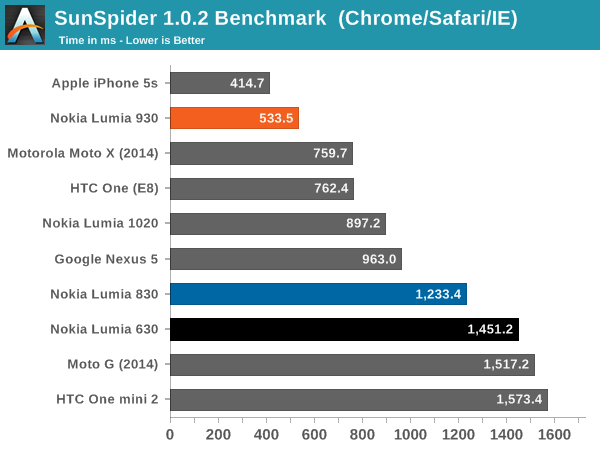
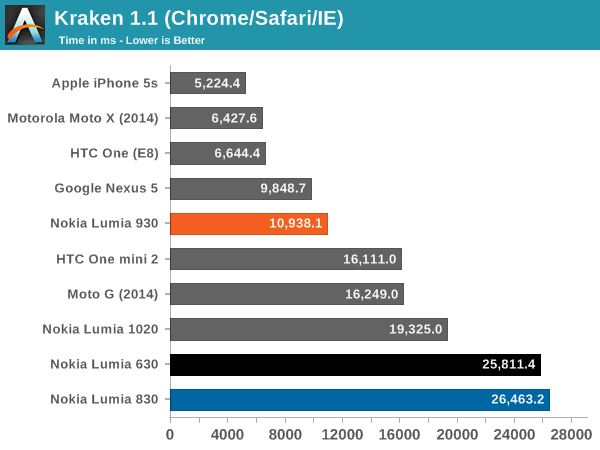
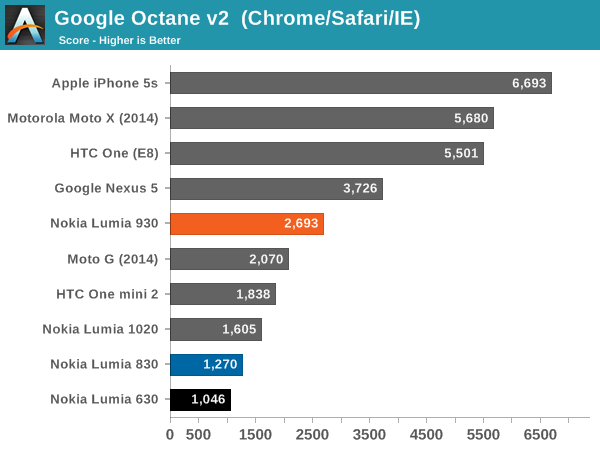
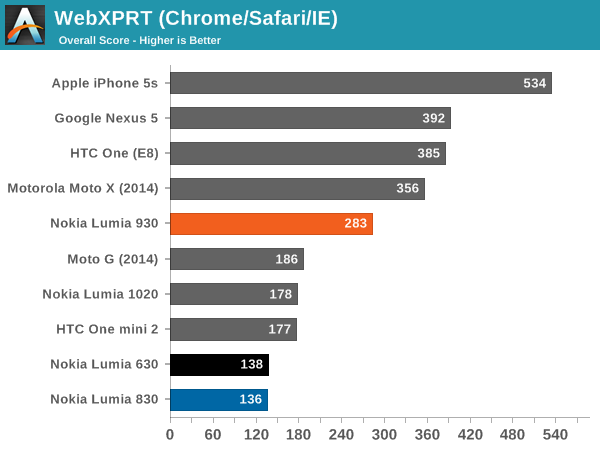
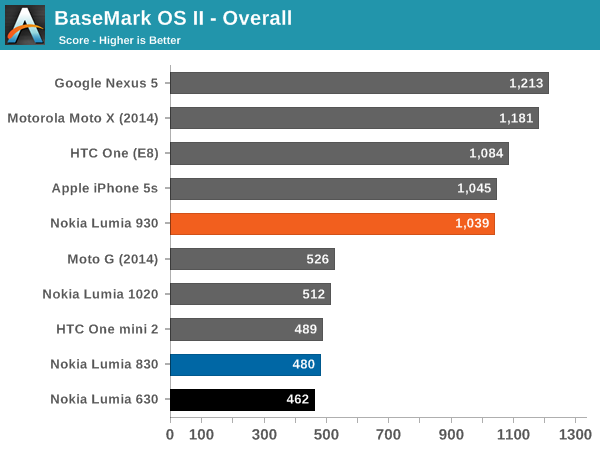
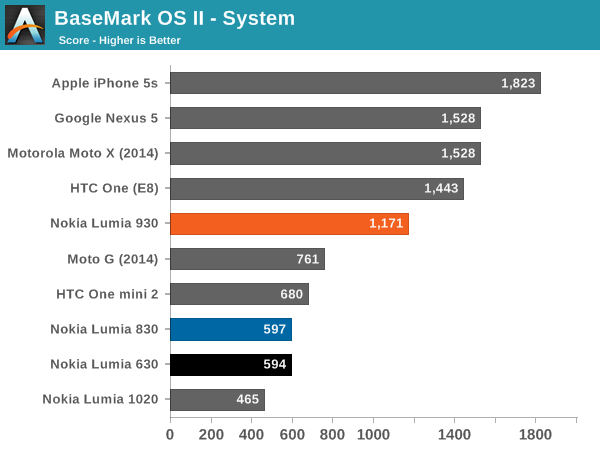
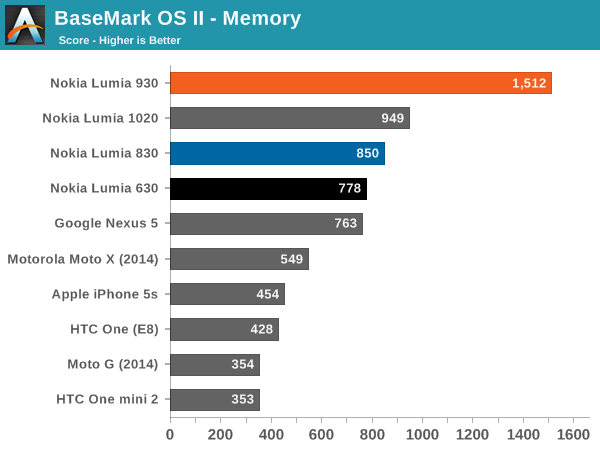
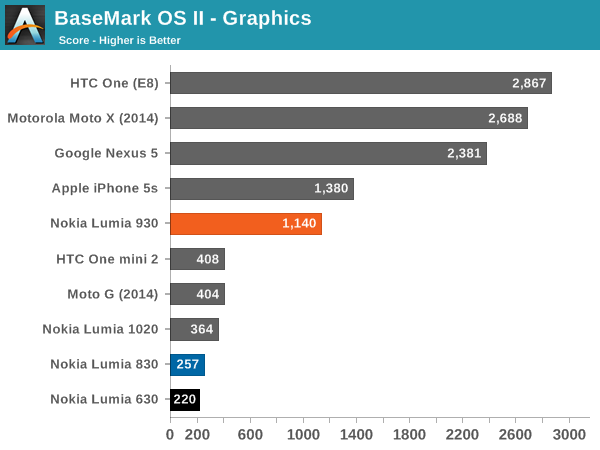
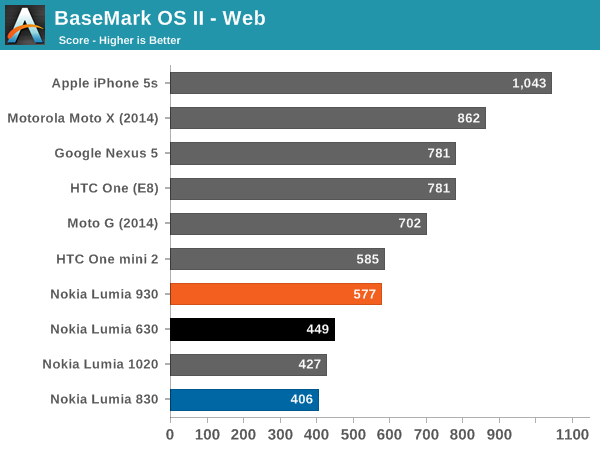
Performance is poor across the board. The Snapdragon 400 with quad-core Cortex A7 just cannot compete with many other phones in a similar price range.
Next up, we will take a look at the GPU performance. This is measured with Basemark X 1.1 and GFXBench numbers, and with a caveat – the current GFXBench version is 3.0, but only 2.7 is available on Windows Phone at the moment (3.0 is listed as coming soon) so we do not have as large of a list of comparable devices for the GPU results.
GPU Performance
The Lumia 630 with only 512 MB of RAM is unable to install GFXBench, but we can still compare the 830 to the 930, 1020, and a couple of other devices. The Adreno 305 GPU in the Snapdragon 400 can be compared to the Adreno 225 in the Lumia 1020, but regardless is quite a step down from the Snapdragon 800’s Adreno 330 GPU found in the Nexus 5 and Lumia 930. Apple has consistently pushed for a better GPU in their products and that shows again here even though these are not the current flagship models from Cupertino.
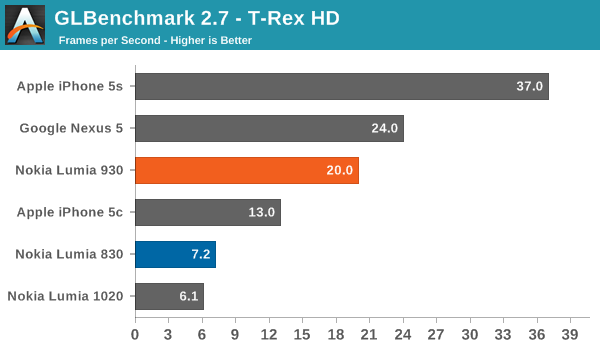
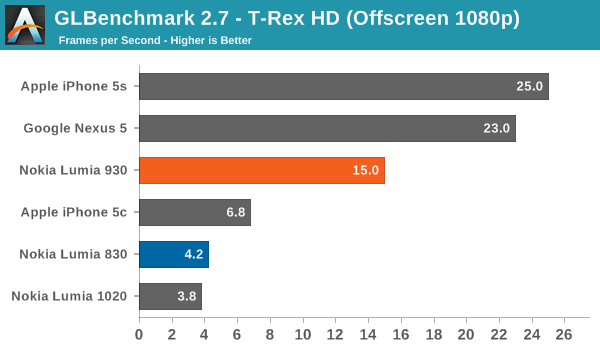
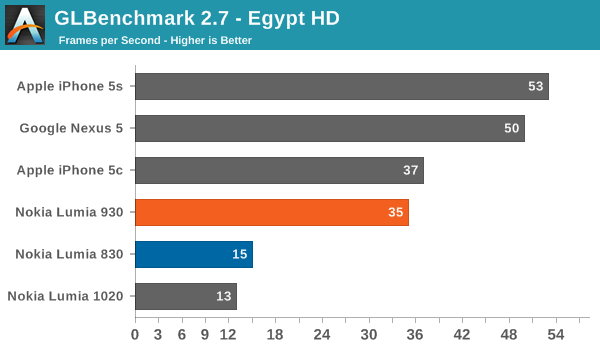
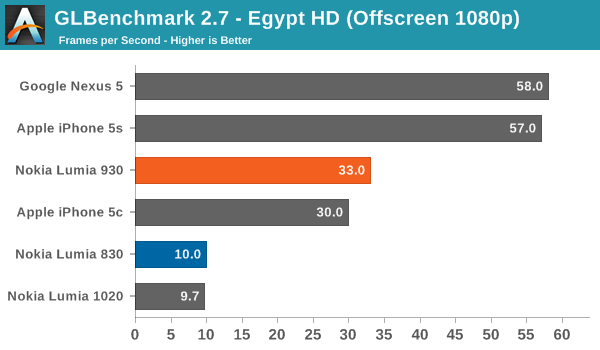
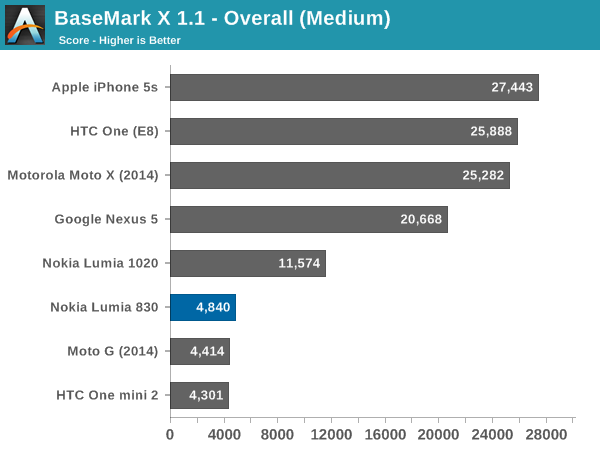
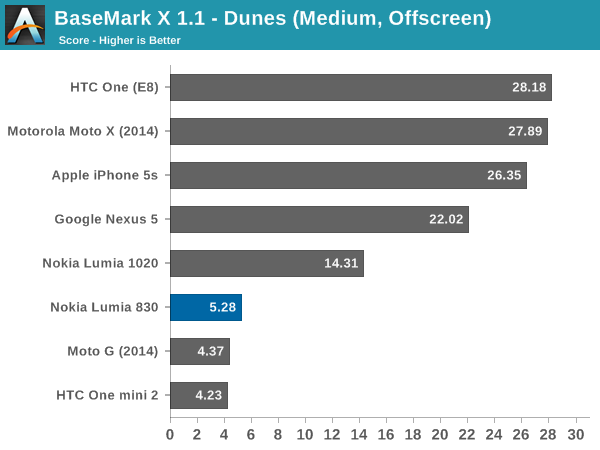
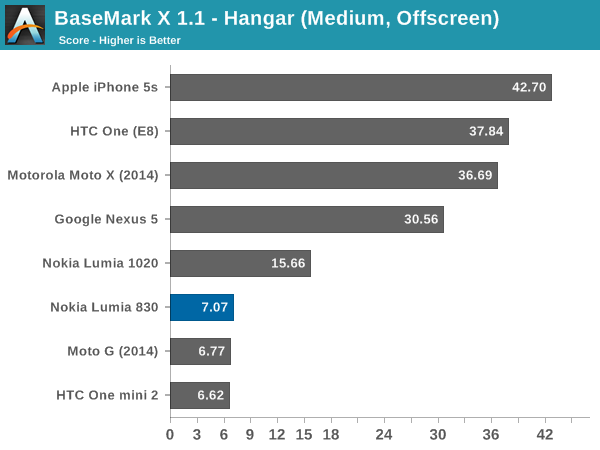
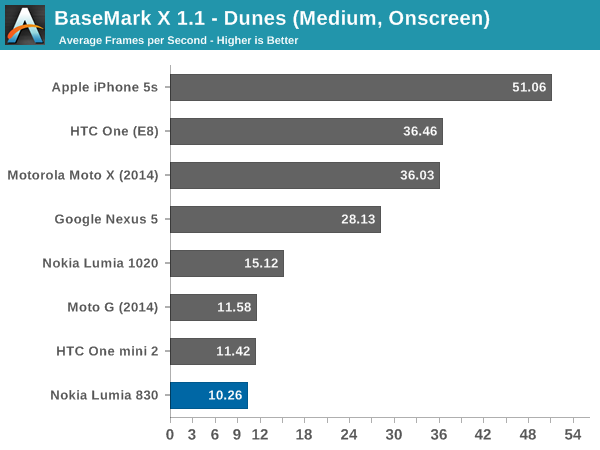
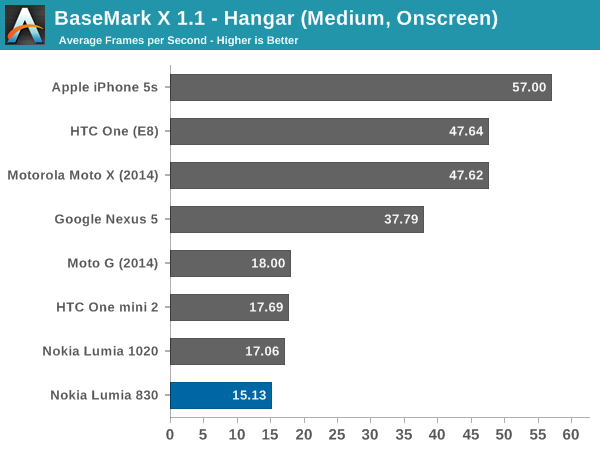
The biggest disappointment with the Lumia 830 is performance. The Lumia 1020 outperforms the 830 in Basemark X 1.1, but both devices fall well short of the Snapdragon 800 Nexus 5. With a device marketed as an “affordable flagship” it would have been nice to see a step up in performance here. The Snapdragon 600 for sure seems like it would have been a perfect fit to fill out the Lumia lineup.
Display
Features such as two-stage camera buttons, multiple microphones for noise cancellation and surround sound video recording, and LTE connectivity are all great, but the one thing you use on any smartphone the most is the display. This means that a good display is something that all manufacturers should focus on. The improvements to smartphone displays over the last several years have been pretty dramatic, but it is still one area where a phones with similar internals can differentiate themselves from the competition.
The Lumia 830 has a five inch 1280x720 resolution IPS LCD. The Lumia line has alternated between Organic LED displays and Liquid Crystal Displays for many of their models. This particular device did end up with a LCD though, which brings the strengths and weaknesses of LCD along with it. Generally, color reproduction is better on a LCD but black levels and contrast cannot match OLED displays, with only the most recent Samsung OLED panels bucking that trend. The resolution of the Lumia 830 is a bit off the 1080p displays we see on higher end phones, but at 294 pixels per inch it is reasonably sharp and falls just under the iPhone 6 and its 326 pixels per inch.
As you can see in the above image, another advantage of LCD is that they are generally a RGB stripe, so there are no extra pixels or pentile matrices to deal with.
As with the Lumia 930, the Lumia 830 also supports “sunlight readability enhancements” which is a method of doing per pixel based content-adaptive backlight control from Apical which helps the perceived image when the device is used outdoors. The brightness is much higher on the 830 than the 930, but these additions can make the device much more usable outdoors.
One of the issues I had with the Lumia 630 when I reviewed it was the display had an almost matte texture to it which caused your finger to catch and drag when using the touchscreen. The Lumia 830’s ClearBlack display suffers none of this, and has a wonderful smooth coating on it which is also easy to clean. One other feature that seems to be somewhat exclusive to Lumia phones is Super Sensitive touch which allows the device to be used with gloves on and still interact with the touch screen. As you will see in the upcoming camera section, this is appreciated in colder climates.
To test the display accuracy, we turn to Spectralcal’s CalMAN 5 software package with a custom workflow. We utilize the X-Rite i1Pro Spectrophotometer for color accuracy and saturation, and the X-Rite i1Display Pro for contrast ratios.
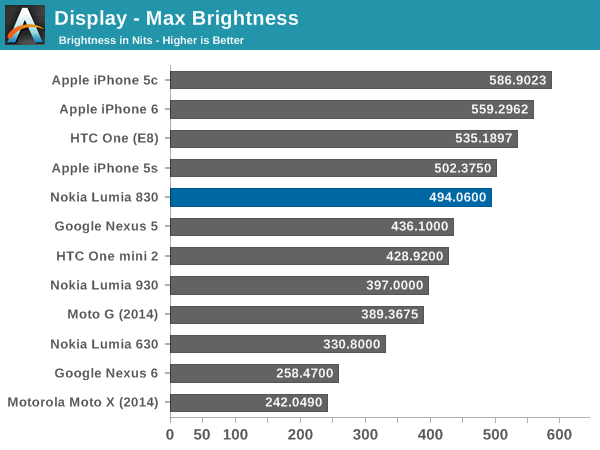
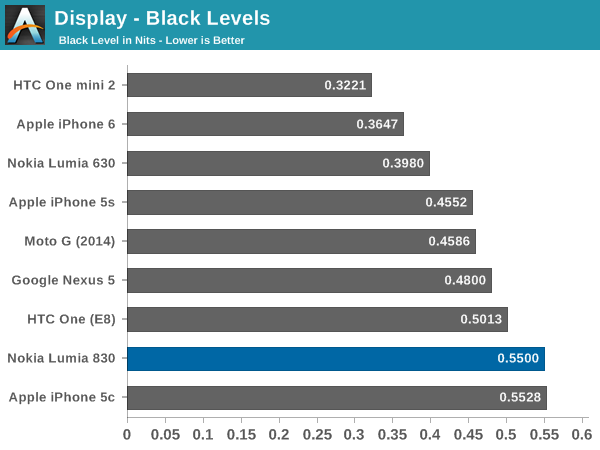
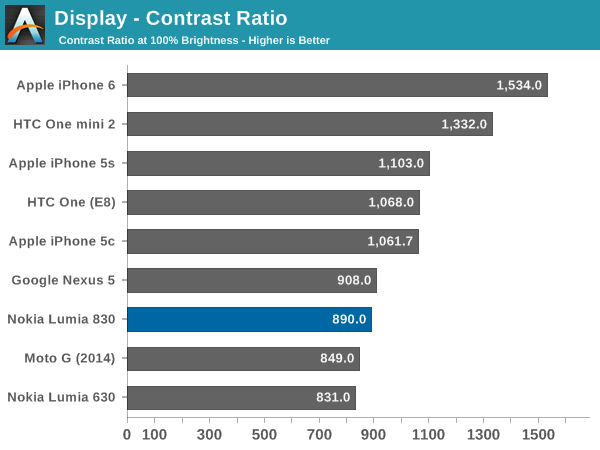
At almost 500 nits, the Lumia 830 is plenty bright for most situations. However the relatively poor black levels result in a contrast ratio that is not spectacular. The black levels are the one thing I noticed while using this device especially when my daily phone is OLED.
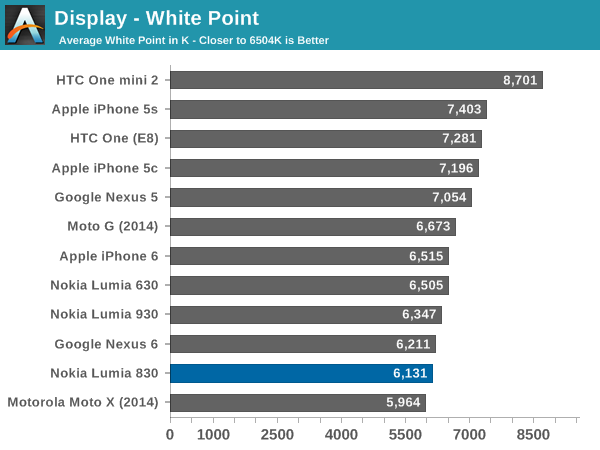
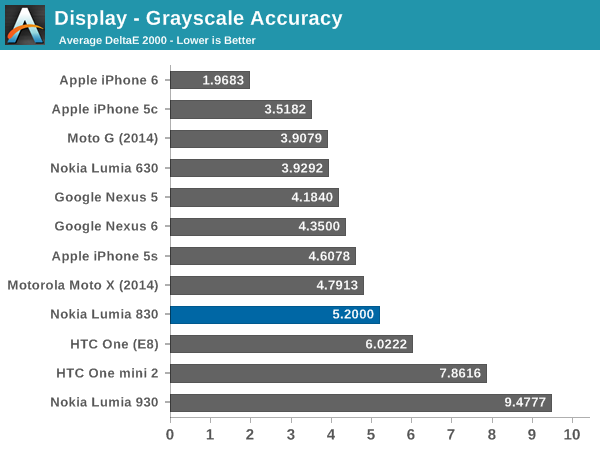
The white point on the Lumia 830 is a bit under what we would be looking for, however you can see from the Calman results that the green starts to shift quite high as the white level rises. That combined with the blue falling away results in a less than amazing 5.207 grayscale average dE2000 score. It is not a great result especially when compared to the Lumia 630, which was one of the better scoring phone displays we have tested and is in a much cheaper device from the same manufacturer. It is clear that the Lumia line has not yet taken display calibration seriously.
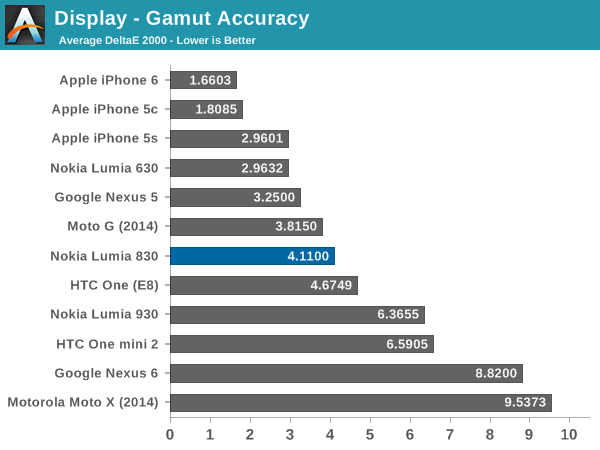
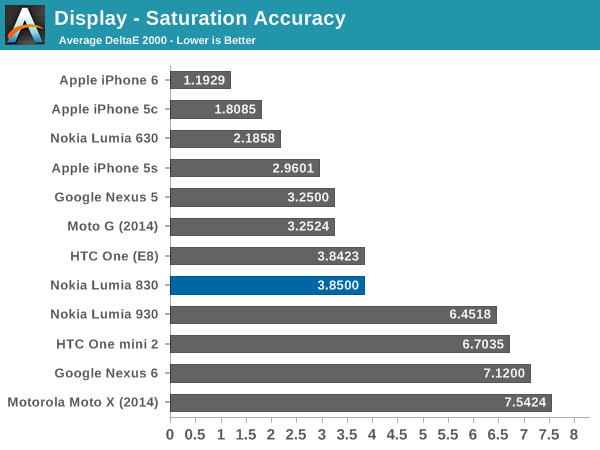
The saturation sweeps are a bit better than grayscale. We are looking for values under 3, and the Lumia 830 is not too far off this mark. At 3.85, it is still quite a way from the Lumia 630’s 2.18 though.
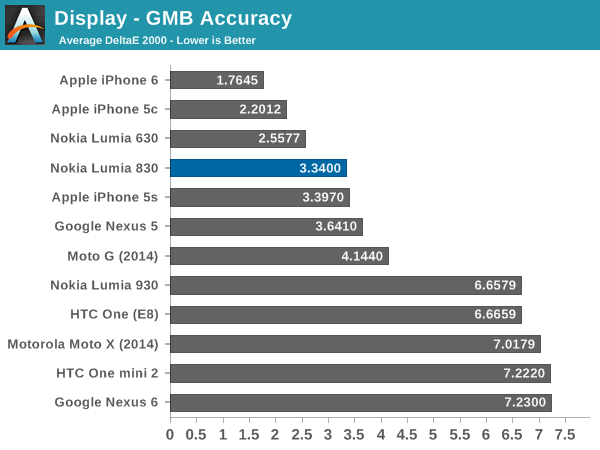
The Lumia 830 does fairly well in the GMB checker, despite the poor grayscale. It comes in with a good, but not great result, and still falls short of the Lumia 630.
The Lumia 830 does support the recently added options for an advanced color profile, which will allow a user to adjust the display to one of three presets (Standard, Vivid, Cool) or to choose Advanced and manually adjust color temperature, tint, and saturation. We are still without a mobile operating system with full color profile support, but this is a good step in the right direction.
Using these settings, you should be able to pull the green down a bit in order to correct the display. The disappointment is that the display is not correct when it leaves the factory though.
The Lumia 830 ends up with a middle of the road LCD. Black levels are not the greatest, but the overall accuracy of the display is not so far off the charts as to be unusable either. The white point is a bit low, but better than some displays which come from the factor with a huge blue shift.
Camera
The Lumia 830 carries the PureView branding on the camera, which Nokia has saved for the heavy hitting cameras. As the line has evolved, the PureView brand appears to be for phones with Optical Image Stabilization (OIS), although as with any branding that may change in the future. The Lumia 830 is by far the lowest end PureView camera so far, with just a 1/3.4” sensor size attached to the OIS mechanism and the six lens optics. The 10.0 megapixel count results in the typical for Lumia 1.1 µm pixel size. The sensor is also a 16x9 native format. The flash is handled by a single LED. It is good to see OIS in a midrange device such as this but the small sensor and small pixel size is going to limit the amount of data that can be collected in dim lighting even with OIS allowing the exposure time to be a bit longer than normal.
To measure camera performance we start with the ISO12233 chart which allows us to test for spatial resolution as well as the amount of processing done by the ISP to get rid of aliasing.
ISO12233 Test Chart
With a smaller sensor size and the same small pixel size, the Lumia 830 cannot do the pixel binning of its PureView brethren. The ISO chart reveals that this is not the same PureView as other devices with the same branding.
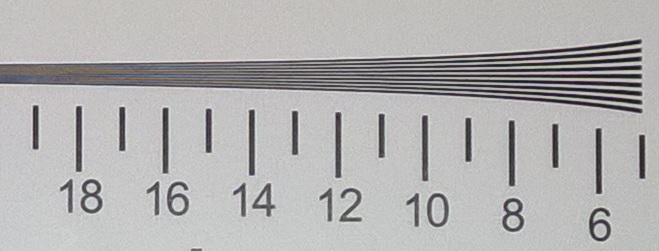
Once we dig into the chart a bit, we can see that the Lumia 830 starts to struggle around the 13 mark on our chart. This is not all about pixel count either, as the lower resolution iPhone can capture up until the 15 mark. The Lumia 930, with its much larger 1/2.5” sensor can pretty much resolve the entire chart and the Lumia 1020 with the PureView 41 MP camera easily resolves the sagittal lines.
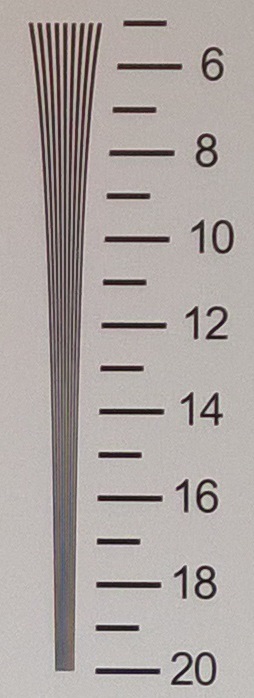
The tangential lines show a similar story, with the Lumia 830 unable to resolve after around the 13 mark. With a 10 MP sensor, I would have hoped to see it resolve at least the same as the iPhone.
Next we will take a look at some controlled scenes.
Controlled Scenes
The Lumia 830 does a good job on a well-lit scenes. The amount of detail is good, and the color balance is very good as well. These shots were taken in full auto, so while it would be possible to correct the Lumia 1020 white balance with the manual controls, most of the time people just leave the camera in auto so it is important for the device to get the right cast.
To stress the camera under poor lighting, we set the light box to 5 lux and leave the flash off. The Lumia 830 does a decent job here again, once again getting the white balance spot on. As compared to the Lumia 1020 photo, there is quite a bit more noise in the final image which is not surprising with the sensor size difference. If you were not going to crop this image it would be very usable.
Outdoor Scenes (Night)
Moving out of the comforts of home, I braved the elements to get some outdoor pictures. The first scene is a park bench which is lit by a low-pressure sodium-vapor light which has a distinctive yellow hue. This scene is dark enough that the image preview on the phone is pretty hard to make out.
The Lumia 830 does a good job with this scene. It keeps some of the yellow cast of the sodium light, but the result is a very usable photo. If you zoom in on it, there is more noise than the 1020 but the overall result is very good.
The picture of the grocery store tells a similar tale. The Lumia 830 gets a better white balance than the Lumia 1020 and the result is a good photo. The Lumia 1020 as always struggles to get the correct white balance when in auto mode even though the resultant picture has much less noise.
Outdoor Scenes (Day)
Moving to daytime, there is generally ample light that even small sensors have no issue getting a reasonable photo.
The Lumia 830 had no issues during daylight with any of the subjects. This picture makes a great comparison with the detail loss as compared to the Lumia 1020. Please ignore the color differences between the photos as the sun ducked behind a cloud, but instead look at the detail of a zoomed in image.
 Lumia 830 (Left) vs Lumia 1020 (right) in Cropped comparison - view at full resolution to see full effect
Lumia 830 (Left) vs Lumia 1020 (right) in Cropped comparison - view at full resolution to see full effect
The Lumia 830 is a good camera for basic point and shoot smartphone photography but it lacks the imaging power of the other PureView phones such as the 930 and 1020. A 1/3.4” sensor and the much lower pixel count removes the ability to do pixel binning to improve the overall result, and it also removes the ability to do lossless zoom.
Another missing feature from the Lumia 830 as compared to the other PureView cameras is the ability to capture in RAW format.
As a still photograph camera, we still need to look at one more feature that can impact camera use – latency.
Capture Latency
Being able to take a photograph quickly can mean the difference between getting a great shot and missing the subject altogether. We have seen a great push in the industry in the last while to improve the focus latency, with some cameras now using phase detection and other tricks to increase the focus speed. The other half of that is the capture latency of taking the photo and saving it so that the camera app is ready to go again. We will start with focus. As with the performance benchmarks, I sampled several phones that may be shopped against the Lumia 830. If you want to check out the 830 against any other device, please visit our benchmark comparison pages in Bench.
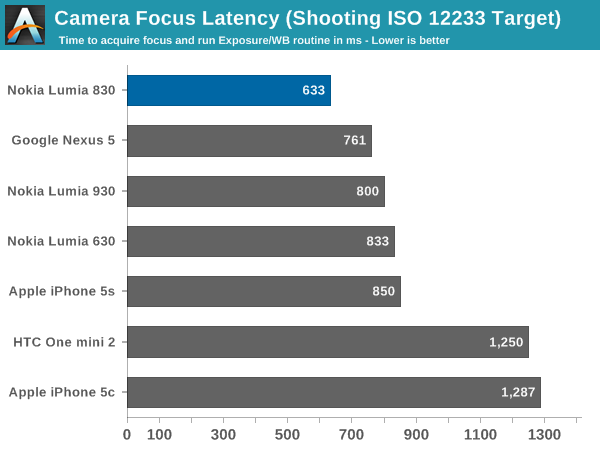
The Lumia 830 is the fastest Lumia I have tested for focus latency, with it occurring in just over 600 ms. While not the outright fastest device for focus we have ever tested, improvement is always welcome. Next up, we will look at the latency to initiate a photo save it to disk.
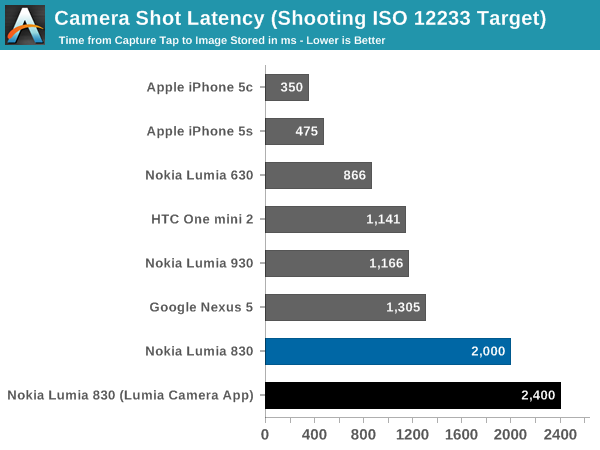
At IFA, Microsoft announced they were going to be launching a new camera app at the end of this year and it cannot come soon enough. The Lumia Camera app is especially slow, with a total capture latency of 2.4 seconds before it is ready for another shot. The default Windows Phone camera app is slightly faster at 2 seconds even. The Lumia 930 outperforms it here which likely means that it is being held back by the slower SoC onboard.
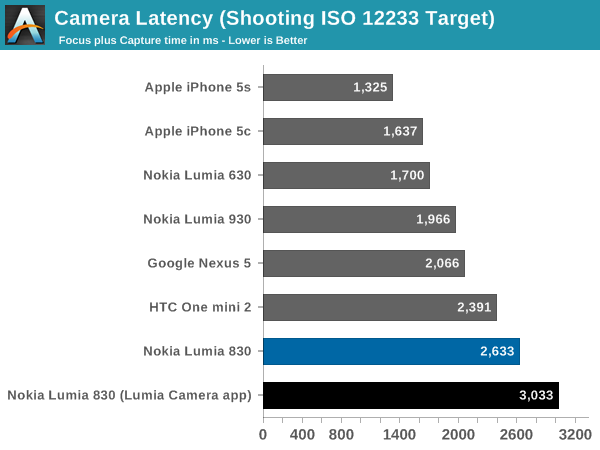
Total latency is the time to focus and the time to capture and save the image. The Lumia 830 is a very slow camera. It is hard to say anymore other than hopefully the new camera app improves this situation.
Video
The 830 has four microphones which allow it to capture video in Dolby Digital surround sound, which is a nice bonus. The video resolution and frame rate options are fairly sparse though, with the only options being 1080p or 720p at 24, 25, or 30 frames per second.
I did two videos with the first one being during the day and the second one at night.
The video during the day was during very high winds (50 km/h+) and with the default low pass filter enabled on the video the amount of wind noise was pretty good.
The night video shows the limits of the sensor quite clearly. OIS helps with the camera shake, but on still photography it allows for an increased exposure time to combat a small sensor. On a video, the sensor gets no such bonus and as such there is quite a bit of noise.
Battery Life
Battery life, like the display, is one of the most important aspects to any smartphone. The Lumia 830 comes with a removable BV-L4A battery, which is a 2200 mAh, with 3.8-volt chemistry. This gives us a battery with 7.04 Wh of capacity. This is quite a bit smaller than the Lumia 930’s 9.20 Wh battery, but it also powers a lower resolution display which is much less power hungry than the Lumia 930’s OLED unit.
As with the performance comparisons, the graphs below are a subset of all of our devices which I chose to compare the Lumia 830 against other phones which are in the same market. Someone considering the Note 4 is likely not cross shopping with a Lumia 830 for instance. If there is a device that we’ve tested, you can use our online benchmark comparison tool Bench to compare any devices we have tested.
To compare battery life, we set all devices to the same brightness level (200 nits) in order to not penalize displays which have a higher maximum brightness. We then put them through several tests a couple of times each to ensure accurate results.
One note is a change to how I am testing Windows Phone battery life. Historically I have run a battery life test, and then done it again with Battery Saver enabled. Battery Saver on Windows Phone stops all background apps from syncing while it is running, and things like email will not work with push support. On our Android reviews, we already disable background syncing while doing battery life testing to ensure consistent results, so starting with the Lumia 830 I will be only showing battery life with Battery Saver enabled. Feel free to give me your feedback in the comments below, but this should give a more accurate result and a baseline we can work off of.
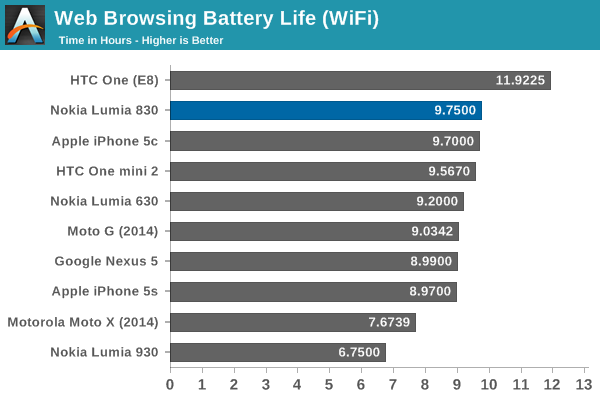
Our first test is web browsing over Wi-Fi. The Lumia 830 is very good here. When doing the Lumia 930 review, that device would actually get warm to the touch just from displaying a white background, but the Lumia 830 does not suffer any of those issues with its LCD display. The result of almost ten hours of screen on time is very good, and should allow almost anyone to easily get through a day of use before needing to charge. Please note that I have adjusted the Lumia 630 and 930 results in the above graph to show them with Battery Saver enabled so that this is an apples-to-apples comparison.
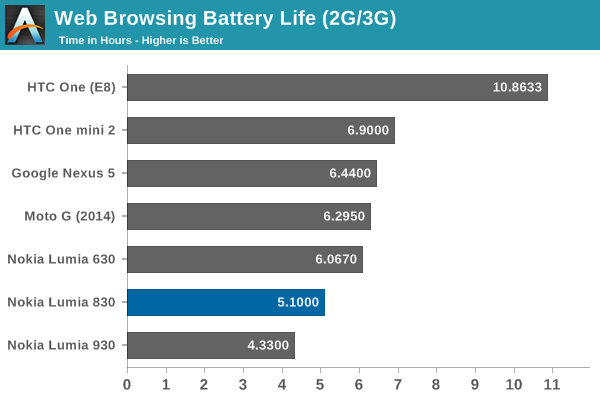
Although the Lumia 830 does support LTE, it will of course fall back to HSPA if the LTE signal is not strong enough. HSPA battery life is not fantastic. I was unable to test LTE battery life on this phone due to the model shipped to me.
In addition to the web browsing test, we have also started to utilize the Basemark OS II Battery Life test.
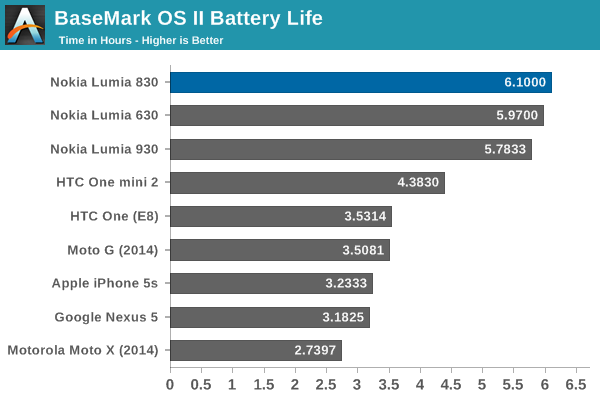
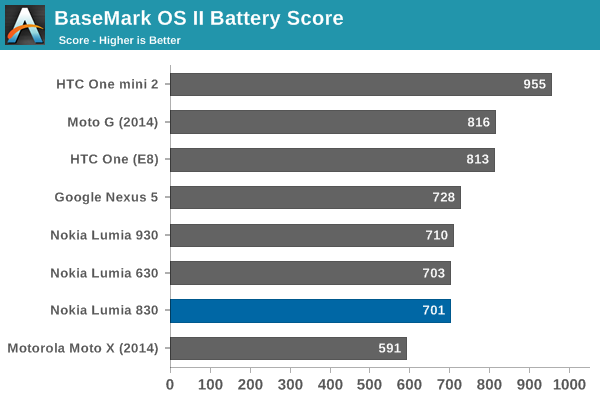
The Lumia 830 does well in the battery life for Basemark, but that does not tell the entire story. The overall score is calculated based on the average battery life loss per minute, as well as the standard deviation and CPU usage during the test. Windows Phone is at a disadvantage here somewhat due to the nature of the benchmark. As it cannot get CPU usage information from the OS, it does not factor it into the final score. While the benchmark was running, the CPU usage was only at 10%.
Charge Time
The speed at which a device can charge can be fairly important if you travel a lot and need to top up. Generally devices charge quickly at the beginning and then ease back over time until they hit 100%, so this is more than just about the overall charge time to 100%. I will now include a graph with the charge percentage over time.
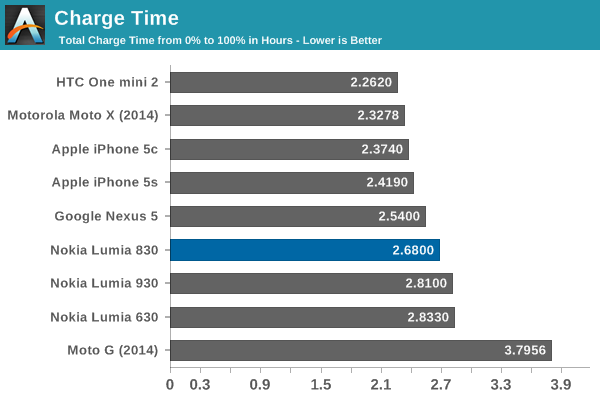
The Lumia 830 comes with a 1.5 Amp micro USB charger, which can fill the battery in about 2:40. This is a higher amperage charger than is included with a device such as the Lumia 630, and it makes a difference. The Snapdragon 400 SoC does support quick charge, at up to 9 volts at 1.5 amps, and Windows Phone does support this.
The Lumia 830 charge rate is fairly consistent all the way up until 90% where it starts to taper off.
For those that hate plugging in their phones, the Lumia 830 also supports Qi wireless charging out of the box.
Wi-Fi
The Lumia 830 most likely unitizes the Qualcomm VIVE Wi-Fi available on the Snapdragon 400 SoC. In this particular case, it is nothing special. The 830 has a single stream only, although at least it is dual band. This gives us a maximum connection speed of 150 Mbps, which the Lumia 830 was able to achieve. However connection speeds rarely equate to real world transfer speeds.
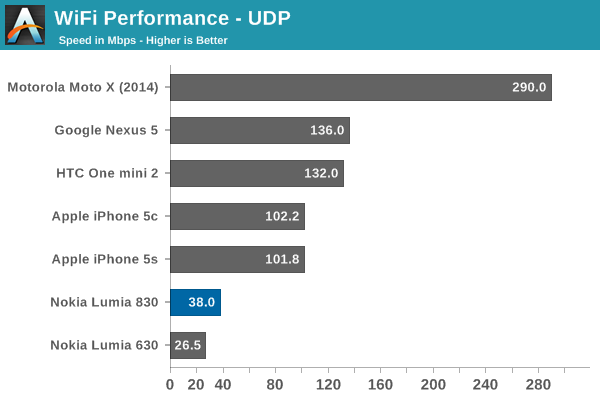
I was only able to achieve 38 Mbps transfer speed with the Lumia 830, which is not a stellar result. On a device of this price range, it would be nice to see 802.11ac wireless and possibly a dual-stream solution.
There is one other note about Wi-Fi. On one occasion, the device stopped seeing any access points at all. I had to restart the phone, at which point the Wi-Fi worked normally again. I’ve contacted Microsoft and this is a known issue on some Lumia 830 devices. They have no fix for this yet, so if you do purchase one and have this happen, you may want to exchange it. It happened just the one time to me though.
Cellular
Qualcomm’s MSM8926 SoC supports up to Category 4 LTE which offers a maximum of 150 Mbps download and 50 Mbps Upload.
I was only able to achieve 6 Mbps download and 4 Mbps upload but these numbers have a lot to do with the traffic on the tower, as well as location and obstacles.
Reception is good but this is difficult to test unless you live on the fringe of a cellular signal and I do not.
GNSS
Qualcomm’s IZat Gen8A is the GPS in the Snapdragon 400 SoC, and as with most modern Qualcomm location solutions it is fast and accurate. With location services enabled on the phone, GPS lock happened within a couple of seconds. Going from location services disabled to a GPS lock took around thirty seconds, which is pretty good.
The Lumia 830 supports A-GLONASS, A-GPS, BeiDou, and assist from cellular and Wi-Fi networks to get a quicker location fix.
Speaker and Call Quality
The Lumia 830 has a single speaker on the back of the device, which is never the ideal location for maximum clarity and volume. The tiny speaker does get plenty loud though. I measured 88.7 dBA from the speaker from 3” away.
The Lumia 830 has four microphones for noise cancelling. Below is the audio of a call from the 830 to my personal cell, which I recorded on my PC. There is a bit of whine in the recording from my PC so please ignore that I will try and get that sorted out for the next review.
The 830 does a good job cancelling out the outside noise during a call, with it only struggling when the ambient noise was high enough that it would be difficult to speak face to face. The audio quality of the call was also quite good.
Software
In our past Lumia reviews, we have gone over a lot of the new features brought to the table by the Lumia line. It makes little sense to rehash the same thing again, so I will just make mention of those before looking at a few new things. Refer back to the Lumia 630 and Lumia 930 reviews for a more in-depth look at the base software.
First, like the other new Lumias launched this year, the 830 also supports “SensorCore” to track movement data. The device hub is also available, as are the HERE navigation maps. Since Microsoft took over Nokia, the “Lumia Collection” in the Windows Phone store has shrunk quite a bit – but that is not a bad thing. There are still apps that are available just for Lumia phones but the majority of the apps have been pushed out to all Windows Phones now. Still, there are unique aspects to the software for the Lumia 830.
The 830 is the first device to ship with the “Lumia Denim” firmware update. Unlike previous releases though, Denim does not bring any major new features yet – although some new features are supposed to be coming soon which are enabled by Denim. Cortana should be able to be launched by voice for instance, and an updated Lumia Camera app is going to speed up photos as well as add missing features such as HDR. But for this review anyway, this is not here yet.
One thing that has been improved in the last month or two though is the Glance screen, and as this is the only Lumia device launched this year with Glance, we can finally discuss it.
In case you are unfamiliar with the Glance screen, it allows information to be displayed on the screen when the device is “off” or sleeping. While this started out as just a basic clock and notifications icons and numbers, it has expanded to include detailed notifications from an app you choose (mine is set to calendar so I can see my next appointment) and the latest update allows display on Glance from certain applications. Right now, those are limited to Health and Weather, so for instance you can take a look at the current temperature and forecast without even turning your phone on.
Glance is one of my favorite features and it has made me reluctant to recommend Lumia phones that were recently launched without it.
In order to enable Glance, the display must support panel self refresh, which was what held back the Lumia 930 from having Glance. That is not the case with the 830 though as it is supported and works well. Lumia phones with OLED displays are better for Glance, as the amount of power required for the display is pretty low when just a bit of white text is being displayed on a black background. For the LCD models (like the 830) the Glance screen runs the backlight at its lowest setting which keeps the power draw down but also makes the Glance text a bit more faint than the OLED version.
One of the Windows Phone requirements is that the basic user interface cannot be modified by OEMs, and all OEM and carrier apps must be able to be removed from the device, but Nokia paved the way to show that even with that in mind, there can be a lot of value added to the platform with software. Though there is not a lot of software changes to speak of on this particular device, that is only because all of the Lumia phones have a lot of the same features. Microsoft will hopefully continue this trend going forward.
Final Words
When the Lumia 830 launched as an “affordable flagship” at IFA 2014, I thought it would be just another midrange phone. But the Lumia 830 has some great features that make it feel like a flagship. The device has a premium feel in-hand, and is much nicer to carry and hold than the actual 930 flagship due to the thickness of the device. It is reasonably light, and keeps the distinctive Lumia polycarbonate back. A real bonus over the 930 is that the back is removable as well, which also allows the device to more easily gain microSD support, which it has.
But the SoC inside the Lumia 830 can detract from the flagship feel. Windows Phone has always had great support for low end phones, so the Snapdragon 400 has no issues with basic animations. It is when you launch apps and do work inside of apps where you can see it struggling for performance. My biggest complaint with the Lumia 830 is that it is too slow to be marketed where it is. There is a huge chasm in performance between the low end Lumias (530, 630, 730, 830) and the high end Lumias (930, 1520). It would be nice to see a progression in speed at some point in the lineup but it is just not there. The SoC does not cripple this device in any way, but after using the Lumia 930 for a while it sure shows that Cortex A7 at 1.2 GHz is pretty pokey.
But the package as a whole is very good if you can overlook the couple of extra seconds it takes to open Skype. The fit and finish of this device is right up there with the high end Lumia phones despite the removable back. It takes a bit of work to get it snapped on, but once it is there it has no flex or creaking of any kind. The camera on the Lumia 830, although a far cry from the 930 and 1020 as far as pure performance, is quite good and has decent low light performance due to the OIS.
I am a bit surprised how much I do like the 830 overall, despite the SoC. The combination of the metal band, a thin chassis, a light weight, a decent display, and a decent camera make for a phone that is very good for the right price.
And with the price we get to the crux of the issue. The Lumia 830 is a great phone for the right price, but it seems that the pricing for it is too high for most locations. As an on-contract phone, the Lumia 830 needs to be at or around $0 on contract. AT&T has it for $99 on contract, which is simply too much for this device. In Canada, it is a different story though with the 830 being $0 on a 2-year contract from all carriers. For an outright price, we are seeing some pretty powerful phones coming in at or around the $400 mark where the 830 is around. Once again, AT&T is a bit higher, but this device needs to be around $350 or so. It has a premium feel, but clearly there were some corners cut so the price should reflect this more.
If you are looking for a midrange Windows Phone today though, the Lumia 830 is certainly one you want to check out.

